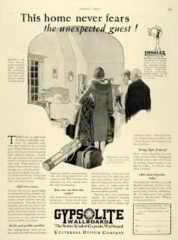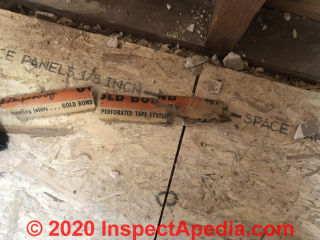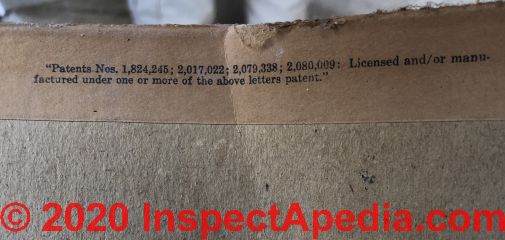 Asbestos Content in National Gypsum Drywall
Asbestos Content in National Gypsum Drywall
Gold Bond™ Gypsolite™ or Fire-Resistant Drywall Asbestos
- POST a QUESTION or COMMENT about the level of asbestos found in drywall on walls & ceilings.
Does National Gypsum drywall, gypsum board, or "sheetrock" contain asbestos?
What about asbestos in Gold Bond™ drywall, National Gypsum Fire-Resistant Drywall, or in Gypsolite?
This article series explains where asbestos is likely to be found in gypsum board or drywall systems, particularly in the taping compound and in skim coats using drywall "mud" that contained asbestos.
InspectAPedia tolerates no conflicts of interest. We have no relationship with advertisers, products, or services discussed at this website.
- Daniel Friedman, Publisher/Editor/Author - See WHO ARE WE?
Does National Gypsum Board contain asbestos? - Some.
 Drywall systems that may contain asbestos - at least in finishes, taping joint compounds, skim coats, or in systems that applied plaster over gypsum board date from about 1910 through the early 1980's in North America (1982 in Canada).
Drywall systems that may contain asbestos - at least in finishes, taping joint compounds, skim coats, or in systems that applied plaster over gypsum board date from about 1910 through the early 1980's in North America (1982 in Canada).
Taping drywall joints dates from as early as the 1920's. Asbestos-use in plaster overlaps this period.
National Gypsum Company (Gold bond™ drywall) has long been one of the major producers of gypsum panels used for building exterior wall sheathing and also for interior wall and ceiling coverings, including gypsum board products and joint compound that contained asbestos.
Some gypsum board or drywall products may have contained asbestos and asbestos was also commonly used in joint compound and other drywall or gypsum board coatings. Gypsolite, first mentioned in building products in 1888, is currently a registered trademark of National Gypsum.
At above/left, a Gypsolite wallboard advertisement from 1926, placed by the Universal Gypsum Company, 111 W. Washington St., Chicago IL.
[Click to enlarge any image]
The National Gypsum company filed for bankruptcy status in 1990, emerged from bankruptcy status in 1993, filed for bankruptcy a second time in 2002 and reorganized in 2003.
Asbestos was used in a number of National Gypsum Gold Bond™ gypsum board products produced between 1950 and 1970.
Asbestos was not used in National Gypsum gypsum-board products after that year.
See GOLD BOND IB ASBESTOS? for details of asbestos use in insulating fiberboard products.
National Gypsum, currently named NGC and headquartered in Charlotte, North Carolina, has manufactured building products, including gypsum wallboard since its founding in 1926.
On 2019-04-21 by (mod) - does National Gypsum Fire-Resistant Gypsum Board contain dangerous asbestos?
RE-posting from private email
Anonymous wrote:
I tried posting a comment to ask a question but was unable too. Could you answer for me?
I am trying to figure out if this dry wall contains anything I should be worried about. The building is a storage facility built in the 70's. I have to replace or patch drywall frequently here. I had a mask on today but I couldn't stop coughing.
A piece of the wall I had torn down said
Underwriters' Laboratories Inc. ( First word could be longer I just have this off a corner piece I looked at before throwing out)
Classified Wallboard
issue NO. B-59 Type FSW-1
then it says fire resistance classification (with a bunch of #s)
G502,G514, L504, L515, L522, U307, U312, U310, U317, U410, X513, X520
See UL Fire Resistance Index
Im not sure if its old or new or if that even means anything. All I know is if im tearing this stuff down all the time I am NOT doing it anymore if its going to kill me. I want to protect my self.
Moderator Reply:
Anon:
Watch out: some 1970's gypsum board and joint compound contain asbestos. A small piece of such material, alone, would not be likely to explain an actual airborne asbestos hazard in such a building, but larger areas of damage or a history of demolition and renovation work involving dusty work with old drywall could indeed have created a dust hazard that merits further testing and clean-up.
But one cannot assume that the gypsum board you cite is from the 1970's without more accurate information about the building and its history.
Your text suggests that you saw a U.S. made drywall identification stamp - the first word would have been Underwriter' Laboratories INC. - or "UL" in popular parlance.
The product - National Gypsum's fire-resistant drywall Type FSW-1 is a fire-resistant gypsum board or drywall - most likely described by the document from National Gypsum that you can read
at GOLD BOND BRAND FIRE SHIELD GYPSUM BOARD [PDF]
As you will read there, those modern National Gypsum Drywall products do not contain asbestos.
It would be helpful to
- know the age of any renovations or remodeling that might have replaced drywall or plasterboard
- see some sharp photos of the material, the stamp you cite, and the edges of the drywall
Watch out: drywall dust, even from drywall that does not contain asbestos (or drywall taping compound that does not contain asbestos as much of that material did), is at least a respiratory irritant against which proper protection and proper dust control and dust clean-up would be sensible.
See SDS No. GB-1501 Gold Bond® BRAND Gypsum Board Products [PDF]
Research on National Gypsum / Gold Bond® / Gypsolite® Asbestos Content
- Bruce, Daniel C., "Composition of matter." U.S. Patent 1,804,245, issued May 5, 1931.
Excerpt from description:
This invention relates to a composition of matter and it is an object of the invention to provide a composition of a soft putty consistency and which is particularly intended 5 to be used as a filler in connection with the application of commercial wall board manufactured from fibres obtained from cane, asbestos, wood, flax, straw, or other absorbitant fibres such as,
and including, the wall 1 board now used and manufactured and known as Celotex, Beaver board, Sheetrock, Best-wall, Masonite, Insolite, Gypsolite, Rockboard, Cornell, or Upson wall board, and other boards made from cane, asbestos, wood, flax, straw, or gypsum. - GOLD BOND BRAND FIRE SHIELD GYPSUM BOARD [PDF] National Gypsum Company Construction Guide , - National Gypsum Corporation, retrieved 4/21/2019, original source: www.nationalgypsum.com/File/fireshieldwb.pdf
- Jones, Thomas. "Finish for plastered walls." U.S. Patent 383,397, issued May 22, 1888. This invention includes the first mention of gypsolite, a gypsum sheathing board widely used in the U.S. including as part of fireproofing systems for oil derricks.
Excerpt:
I may, as the first step in my improvements, employ a preliminary treatment of gypsum rock or uncalcined gypsum, which treatment consists in steeping such rock (which, for convenience, may be broken into pieces of, say,two to three pounds weight) in a solution of sulphuric acid-say ten parts of acid to one hundred parts of water-for a period of, say, ten days.
The gypsum is then removed from the acid solution, dried, and reduced to a powder. To this gypsum powder I add pulverized potash alum, or its equivalents, in about the proportion of ten parts of alum to one hundred parts of gypsum, by weight, and thoroughly mix them. This compound I will designate as gypsolite. It will form one ingredient of my improved finish. - National Gypsum Properties, LLC., registered Gypsolite as a trademark filed 10/05/1942 and has renewed the trademark since that date. The Gypsolite trademark registered by National Gypsum bears serial No. 71455985 registered under goods and services, "Plaster".
- SDS No. GB-1501 Gold Bond® BRAND Gypsum Board Products [PDF] Op. Cit. Safety Data Sheet from National Gypsum
- Varma, Amit H., Sangdo Hong, and Lisa Choe. "Fundamental behavior of CFT beam-columns under fire loading." Steel Compos Struct 15, no. 6 (2013): 679-703.
Excerpt:
... and fireproofing thickness in ... compressive strengths on the day of the tests are shown in Table 1. Gypsum plaster (Gold Bond Gypsolite plaster) was used as the fire proofing material for ... - At ASBESTOS PRODUCING COMPANIES & TRUSTS you will see that SOME National Gypsum products did contain asbestos.
...
Reader Comments, Questions & Answers About The Article Above
Below you will find questions and answers previously posted on this page at its page bottom reader comment box.
Reader Q&A - also see RECOMMENDED ARTICLES & FAQs
On 2020-11-17 by Brad - tearing down plaster over National Gypsum Company wallboard.
Demo'ed a small bathroom, found out we had been tearing down plaster over National Gypsum Company wallboard.
I had the plaster tested for asbestos, but not the wallboard.
And now I am reading that it could possible contain asbestos as well. House was built in the 1950's. I have ordered a kit to have the wallboard tested.
My question is my house now contaminated with asbestos? We wore respirators and plastic over the doors but have been in and out of the bathroom since. How concerned should I be at this point.
On 2020-11-17 by (mod) - How do I Decide if Further Cleanup of Asbestos-suspect Dust Contamination is Needed for My Home?
Brad
Thank you for the helpful question.
Regrets but no one can make a useful guess about whether or not your home is contaminated with asbestos-laden dust from a brief e-text.
What you can do, besides testing samples of the original demolished materials for asbestos content, is toCollect a few representative samples of settled dust that is likely to represent dust that was created and deposited during the demolition that you cite.
Often we can find that "old" dust by looking at flat surfaces that are not regularly wiped clean, such as horizontal trim over a window or door, or atop a high shelf that's seldom accessed, or atop a refrigerator.
The procedure
at TEST KIT for DUST, MOLD, PARTICLES: INSTRUCTIONS
explains how to collect dust samples: clear Scotch tape, in the dust, then stuck directly to the outside of a freezer-type Ziplok bag works.
Send your sample(s) to a certified asbestos lab.
If the lab finds significant levels of asbestos in that dust then further cleaning may be justified in your home, involving usuall damp wiping and HEPA vacuuming of surfaces.
Watch out: When asking consultants for help or advice about envrionmental or other potentially expensive or risky building conditions, beware of the OTHER PEOPLE's MONEY problem
On 2020-06-21 - by Anonymous: Asbestos in 1950s Gold Bond gypsum-board from National Gypsum?
My wife and I are removing untapped drywall from our garage (built in late 50s). The boards are less than 5/8” thick, more like 1/4”, but they are stamped with Gold Bond, and that made me nervous about the possible asbestos content.
Did Gold Bond Sheetrock that isn’t fireproof thickness usually contain asbestos?
This discussion was posted originally
at SHEATHING, FIBERBOARD ASBESTOS CONTENT
Moderator reply:
Probably not, but nobody with any sense is going to bet your health and money on a claim for the presence or absence of asbestos in a material by e-text alone; I would either treat the material as presumed to contain asbestos or have a sample tested.
It's not expensive to do that. Let me know what you decide and also send along photo of the material, its edge, and any stampings or markings that you can and I may be able to comment further.
Reader follow-up:
Thank you! So not all Gold Bond Sheetrock from the 50s contained asbestos? Some online asbestos lawyer sites always make it seem like everything with this label is an ACM.
Was asbestos added to Gold Bond mostly for walls that needed extra fire protection? It seems like all the stuff we have is 1/4”.
Thank you for your expertise!
... on closer inspection the product stamped with Gold Bond were wood/cellulose fiberboard. The drywall has no label that I can see. Sorry for the mess up!
Moderator reply:
I have found no authoritative source demonstrating by historical document research (nobody has samples that they can claim represent absolutely all production runs and product versions of drywall) that all Gold Bond drywall contained asbestos.
There is, of course, still a cross-contamination risk.
For example wood-based fiberboard panels - basically a cellulose, not asbestos, product - were in some cases reported to have been cross-contaminated by asbestos present (for other products) at the site where they were produced.
Asbestos was added to many products for improved fire resistance but also in some products like floor tiles, as a filler (shorts or powder) and as a strengthener (longer fibers).
Question: asbestos in 3/8" Gold Bond Gypsum Board from the 1950s?
I came across some fireproof Gold Bond 3/8 gypsum board during a renovation. Markings label it as perforated tape system and the patent numbers seem to have expired before 1955. Do you know if this product was known to contain asbestos?
Thank you for any information you might have. - 2019/05/16 Anonymous by private email
Moderator reply:
The best info we have is above on this page; I'll post updates on anything further our research turns-up.
...
Continue reading at ASBESTOS-DRYWALL REMEDIATION / REMOVAL or select a topic from the closely-related articles below, or see the complete ARTICLE INDEX.
Or see these
Recommended Articles
- ASBESTOS CEMENT CEILING & WALL PANELS
- ASBESTOS in DRYWALL
- ASBESTOS in DRYWALL MUD - TEST LOCATIONS
- BESTWALL DRYWALL ASBESTOS
- CANADIAN DRYWALL ASBESTOS
- CANADIAN GYPSUM LIME & ALABASTINE GLA DRYWALL ASBESTOS?
- CELOTEX DRYWALL ASBESTOS
- CERTAINTEED DRYWALL ASBESTOS
- CGC GYPROC DRYWALL ASBESTOS?
- COATING TYPE CEILING & WALL SURFACES: CATALOG OF
- DRYWALL & GYPSUM BOARD COMPOSITION & HISTORY
- DRYWALL TYPE IDENTIFICATION STAMPS
- GENSTAR GYPSUM LTD ASBESTOS?
- GYPSUM BOARD GYP ROCK SHEATHING
- GYPSUM BOARD PLASTER LATH SYSTEMS
- IGNIFUGE GYPSUM BOARD ASBESTOS?
- NATIONAL GYPSUM DRYWALL ASBESTOS?
- PICTURE HANGING NAILS to avoid damage/dust
- PLASTER TYPES & METHODS in BUILDINGS
- US GYPSUM SHEETROCK ASBESTOS
- SHEATHING, GYPSUM BOARD
- ASBESTOS-DRYWALL REMEDIATION / REMOVAL
- ASBESTOS IDENTIFICATION IN BUILDINGS
- ASBESTOS LIST of PRODUCTS
- ASBESTOS in PLASTER - what about the use of asbestos in plaster walls & ceilings?
- ASBESTOS PRODUCING COMPANIES & TRUSTS - complete list includes all asbestos-containing drywall producing companies
- NATIONAL GYPSUM CEILING TILES
Suggested citation for this web page
NATIONAL GYPSUM DRYWALL ASBESTOS? at InspectApedia.com - online encyclopedia of building & environmental inspection, testing, diagnosis, repair, & problem prevention advice.
Or see this
INDEX to RELATED ARTICLES: ARTICLE INDEX to ASBESTOS HAZARDS
Or use the SEARCH BOX found below to Ask a Question or Search InspectApedia
Ask a Question or Search InspectApedia
Try the search box just below, or if you prefer, post a question or comment in the Comments box below and we will respond promptly.
Search the InspectApedia website
Note: appearance of your Comment below may be delayed: if your comment contains an image, photograph, web link, or text that looks to the software as if it might be a web link, your posting will appear after it has been approved by a moderator. Apologies for the delay.
Only one image can be added per comment but you can post as many comments, and therefore images, as you like.
You will not receive a notification when a response to your question has been posted.
Please bookmark this page to make it easy for you to check back for our response.
IF above you see "Comment Form is loading comments..." then COMMENT BOX - countable.ca / bawkbox.com IS NOT WORKING.
In any case you are welcome to send an email directly to us at InspectApedia.com at editor@inspectApedia.com
We'll reply to you directly. Please help us help you by noting, in your email, the URL of the InspectApedia page where you wanted to comment.
Citations & References
In addition to any citations in the article above, a full list is available on request.
- In addition to citations & references found in this article, see the research citations given at the end of the related articles found at our suggested
CONTINUE READING or RECOMMENDED ARTICLES.
- Carson, Dunlop & Associates Ltd., 120 Carlton Street Suite 407, Toronto ON M5A 4K2. Tel: (416) 964-9415 1-800-268-7070 Email: info@carsondunlop.com. Alan Carson is a past president of ASHI, the American Society of Home Inspectors.
Thanks to Alan Carson and Bob Dunlop, for permission for InspectAPedia to use text excerpts from The HOME REFERENCE BOOK - the Encyclopedia of Homes and to use illustrations from The ILLUSTRATED HOME .
Carson Dunlop Associates provides extensive home inspection education and report writing material. In gratitude we provide links to tsome Carson Dunlop Associates products and services.



